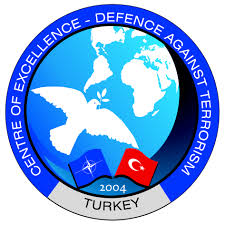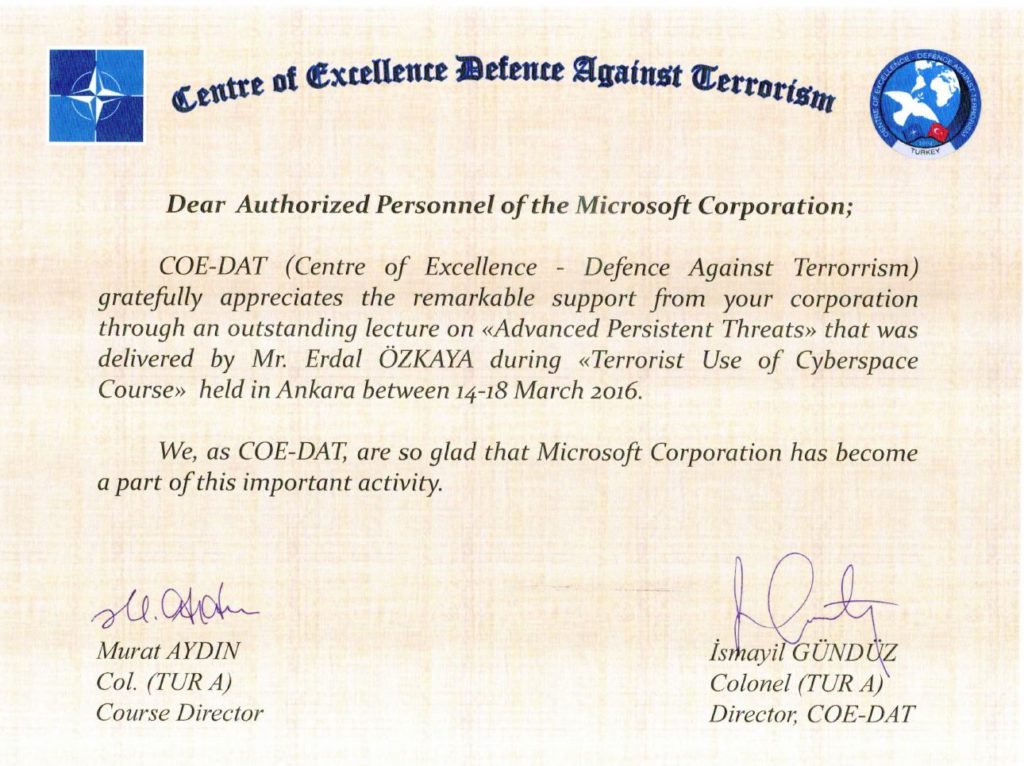
NATO Center of Excellence Appreciation Award , thankful < 3
NATO Center of Excellence Appreciation Award
Who is CEO DAT ?
Center of Excellence Defense Against Terrorism (CEO DAT) is part of NATO . You can get more information about CEO DAT in their web page
Welcome Letter
On behalf of the COE-DAT team, I welcome you to our Centre where we focus our efforts on transforming NATO in the realm of counter-terrorism (CT). I would like to congratulate you on your selection to participate in one of our highly sought after CT related activities!
We exist “to provide key decision-makers with realistic solutions to terrorism and CT challenges”. Simply put, you are our mission, because through your active participation, contributions, knowledge sharing, and networking it is our aim that you will have the skillsets and desire to make a difference as we work together to combat this acute, global threat posed by terrorism.
we look forward to meeting you, learning from you, and having an enjoyable time together as we explore the strategic and operational aspects of CT, develop friendships and relationships, build trust, and advance our common interests related to CT.
CEO DAT is a NATO QA Accredited organization.
CEO DAT awarded me with the CEO DAT Appreciation Certificate for my contribution in their Defense Against Terrorism course, with my Advanced Persistent Threats presentation. I will continue to support CEODAT and NATO as much as I can .

Thank you
NATO In WikiPedia
The North Atlantic Treaty Organization (NATO, /ˈneɪtoʊ/; French: Organisation du traité de l’Atlantique nord, OTAN), also called the North Atlantic Alliance, is an intergovernmental military alliance between 30 European and North American countries. The organization implements the North Atlantic Treaty that was signed on 4 April 1949.[3][4] NATO constitutes a system of collective defence whereby its independent member states agree to mutual defence in response to an attack by any external party. NATO’s Headquarters are located in Haren, Brussels, Belgium, while the headquarters of Allied Command Operations is near Mons, Belgium.
Since its founding, the admission of new member states has increased the alliance from the original 12 countries to 30. The most recent member state to be added to NATO was North Macedonia on 27 March 2020. NATO currently recognizes Bosnia and Herzegovina, Georgia, and Ukraine as aspiring members.[5] An additional 20 countries participate in NATO’s Partnership for Peace program, with 15 other countries involved in institutionalized dialogue programs. The combined military spending of all NATO members in 2020 constituted over 57% of the global nominal total.[6] Members agreed that their aim is to reach or maintain the target defence spending of at least 2% of their GDP by 2024.[7][8]
On 4 March 1947, the Treaty of Dunkirk was signed by France and the United Kingdom as a Treaty of Alliance and Mutual Assistance in the event of a possible attack by Germany or the Soviet Union in the aftermath of World War II. In 1948, this alliance was expanded to include the Benelux countries, in the form of the Western Union, also referred to as the Brussels Treaty Organization (BTO), established by the Treaty of Brussels.[9] Talks for a new military alliance, which could also include North America, resulted in the signature of the North Atlantic Treaty on 4 April 1949 by the member states of the Western Union plus the United States, Canada, Portugal, Italy, Norway, Denmark and Iceland.[10]

The North Atlantic Treaty was largely dormant until the Korean War initiated the establishment of NATO to implement it, by means of an integrated military structure: This included the formation of Supreme Headquarters Allied Powers Europe (SHAPE) in 1951, which adopted the Western Union’s military structures and plans.[11] In 1952, the post of Secretary General of NATO was established as the organization’s chief civilian. That year also saw the first major NATO maritime exercises, Exercise Mainbrace and the accession of Greece and Turkey to the organization.[12][13] Following the London and Paris Conferences, West Germany was permitted to rearm militarily, as they joined NATO in May 1955, which was, in turn, a major factor in the creation of the Soviet-dominated Warsaw Pact, delineating the two opposing sides of the Cold War.
The building of the Berlin Wall in 1962 marked a height in Cold War tensions, when 400,000 US troops were stationed in Europe.[14] Doubts over the strength of the relationship between the European states and the United States ebbed and flowed, along with doubts over the credibility of the NATO defence against a prospective Soviet invasion – doubts that led to the development of the independent French nuclear deterrent and the withdrawal of France from NATO’s military structure in 1966.[15][16] In 1982, the newly democratic Spain joined the alliance.[17]
The Revolutions of 1989 in Europe led to a strategic re-evaluation of NATO’s purpose, nature, tasks, and focus on that continent. In October 1990, East Germany became part of the Federal Republic of Germany and the alliance, and in November 1990, the alliance signed the Treaty on Conventional Armed Forces in Europe (CFE) in Paris with the Soviet Union. It mandated specific military reductions across the continent, which continued after the collapse of the Warsaw Pact in February 1991 and dissolution of the Soviet Union in that December, which removed the de facto main adversaries of NATO.[18] This began a draw-down of military spending and equipment in Europe. The CFE treaty allowed signatories to remove 52,000 pieces of conventional armaments in the following sixteen years,[19] and allowed military spending by NATO’s European members to decline by 28% from 1990 to 2015.[20]

In the 1990s, the organization extended its activities into political and humanitarian situations that had not formerly been NATO concerns.[21] During the break-up of Yugoslavia, the organization conducted its first military interventions in Bosnia from 1992 to 1995 and later Yugoslavia in 1999.[22] These conflicts motivated a major post-Cold War military restructuring. NATO’s military structure was cut back and reorganized, with new forces such as the Headquarters Allied Command Europe Rapid Reaction Corps established. The changes brought about by the collapse of the Soviet Union on the military balance in Europe since the CFE treaty were recognized in the Adapted Conventional Armed Forces in Europe Treaty, which was signed at the 1999 Istanbul summit.[citation needed]
Politically, the organization sought better relations with the newly autonomous Central and Eastern European nations, and diplomatic forums for regional cooperation between NATO and its neighbours were set up during this post-Cold War period, including the Partnership for Peace and the Mediterranean Dialogue initiative in 1994, the Euro-Atlantic Partnership Council in 1997, and the NATO–Russia Permanent Joint Council in 1998. At the 1999 Washington summit, Hungary, Poland, and the Czech Republic officially joined NATO, and the organization also issued new guidelines for membership with individualized “Membership Action Plans“. These plans governed the addition of new alliance members: Bulgaria, Estonia, Latvia, Lithuania, Romania, Slovakia, and Slovenia in 2004, Albania and Croatia in 2009, Montenegro in 2017, and North Macedonia in 2020.[citation needed] The election of French President Nicolas Sarkozy in 2007 led to a major reform of France’s military position, culminating with the return to full membership on 4 April 2009, which also included France rejoining the NATO Military Command Structure, while maintaining an independent nuclear deterrent.[16][23][24]
Article 5 of the North Atlantic treaty, requiring member states to come to the aid of any member state subject to an armed attack, was invoked for the first and only time after the September 11 attacks,[25] after which troops were deployed to Afghanistan under the NATO-led ISAF. The organization has operated a range of additional roles since then, including sending trainers to Iraq, assisting in counter-piracy operations[26] and in 2011 enforcing a no-fly zone over Libya in accordance with UN Security Council Resolution 1973. Article 4, which merely invokes consultation among NATO members, has been invoked five times following incidents in the Iraq War, Syrian Civil War, and Russia’s annexation of Crimea.[27] This annexation led to strong condemnation by NATO nations and the creation of a new “spearhead” force of 5,000 troops at bases in Estonia, Lithuania, Latvia, Poland, Romania, and Bulgaria.[28] At the subsequent 2014 Wales summit, the leaders of NATO’s member states formally committed for the first time to spend the equivalent of at least 2% of their gross domestic products on defence by 2024, which had previously been only an informal guideline.[29] In 2014, only 3 out of 30 NATO members reached this target (including the US); by 2020 this had increased to 11. Taken together, in 2020, the 29 non-US member states had six consecutive years of defence spending growth, bringing their average spending to 1.73% of GDP.[30] NATO did not condemn the 2016–present purges in Turkey.[31] As a result of the Turkish invasion of Kurdish-inhabited areas in Syria, Turkey’s intervention in Libya and the Cyprus–Turkey maritime zones dispute, there are signs of a schism between Turkey and other NATO members.[32][33] NATO members have resisted the UN’s Nuclear Weapon Ban Treaty, a binding agreement for negotiations for the total elimination of nuclear weapons, supported by more than 120 nations.[34]





